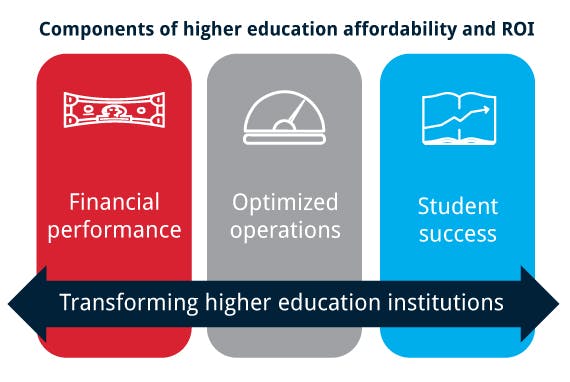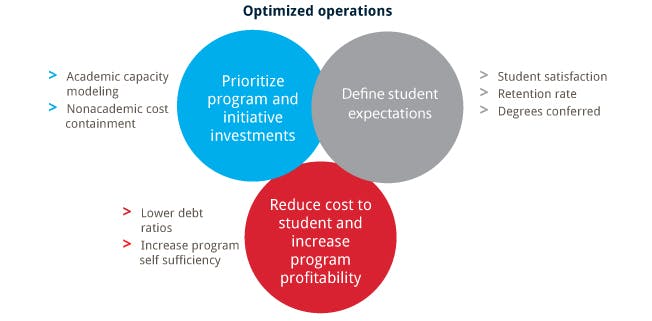
Transforming for affordability and student success
Demands for affordability
Higher education institutions face increasing demands to change their business models. Top of mind for government officials, administrators, parents, and students is the need to reduce the cost of a degree and the amount of student debt. At the same time, students are coming to college with higher expectations and greater needs.
These conflicting demands are tough to balance for higher education leaders. They are forced to ensure a return for every dollar invested in programs, faculty, and students. The intersection of financial, operational, and student success will transform higher education institutions that want to survive into the future.

A strategic approach to financial decisions will require a keen and continuous eye on financial performance. Effective use of fiscal ratios, proactive shifts in resource prioritization, and real time access to critical data will be the norm. Likewise, financial aid decision makers and other key grant sources will scrutinize, like never before, every institution’s answer to the following questions:
What is the strategy for variances in cost per different degrees?
- How do programs and departments compare to standards or averages when considering administrative to academic cost ratios?
- Why, with enrollment on a significant decline, are operating and administrative costs increasing significantly?
To remain competitive and ensure positive student success, higher education institutions must find opportunities to offer “in-demand” student experiences at the lowest cost feasible without impacting program or academic integrity.
Measuring student success
A student’s potential experience will determine the amount of funding an institution receives. Metrics for measuring student experience are therefore more prevalent than ever before, and grow increasingly important. To receive their share of limited funds, institutions will have to prove their case in these areas:
- Student satisfaction scores
- Retention trends
- Graduation rates
Optimized operations
Cost containment and prioritized budget allocations toward the highest return will be the mantra moving forward. Accountability will increase at all levels, requiring institutions to prove that allocations are strategic and deliver a return for the institution and the student. Reductions in non-academic costs are assumed, and changes to academic resource allocation and approaches are anticipated.

Our customized studies, financial modeling and financial ratios provide colleges and universities with critical tools to understand where their financial performance falls short and how they can improve it. These institutions can also rely on Baker Tilly to help them identify concrete strategies for providing students more value with fewer resources by better managing budgets, eliminating waste in time, and benchmarking performance.
For more information on this topic, or to learn how Baker Tilly higher education specialists can help, contact our team.